On a recent visit to a picnic park with a small woodland, I looked over to where the closely mown lawn adjoins an unmown meadow. The rougher area is just starting to sprout taller growth with various grasses, burdock, thistles and asters. There was a flock of at least 7 robins on the lawn and I wanted to examine them in case any were actually migrating thrushes.
Suddenly, my eye landed on a set of three birds walking single file quickly into the taller meadow. As I grabbed for my camera, my mind was racing: They were walking the way you see a mother duck leading its ducklings; the birds were dull browns; the two youngsters were almost as large as the leader of the line; they would have to be a small breed of ducks as the birds were about twice as big as a robin but half the size of a mallard; would a mallard even have such mature young already?
Small Bird Hobbles to the Defence of Its Brood
I took a half-dozen steps, when a bird flew clumsily up out of the tall grasses and plummeted onto the lawn at my feet. It was only about a metre away from me! Immediately, this worried adult began displaying for me, walking around me in circles, alternately flapping weakly, crouching with its wings half-spread, and later on even calling long low peeps at me.
It wasn’t a killdeer. I’ve often seen them trying to lure me away from their nests or young. It wasn’t a Ruffed Grouse, which one time tried to draw me away from its powder-puff babies as they tumbled through the road side weeds. I had seen this type of bird up close once before, though, as a teenager on a banding trip to Prince Edward Point. It was an American Woodcock.
I stood still, only pivoting to get a few rapid fire photos in the poor gloomy light. I really, really wanted to get a photo of the three birds walking single file and I wanted the poor parent to realize I was not a threat. After a few seconds more, I also realized I wanted to stay nearby in case an off leash dog happened along the path. Like the parent bird, I would try to protect the youngsters if needed!
The Woodcock gave up on me after a minute or two and flew off in the wrong direction, probably to confuse me if I was still interested in pursuing it. I stayed still, scanning the overgrown tangle of grasses and dead burdock, thistle and goldenrod stems for any signs of motion.
Eventually, making a wide circle around the place the youngsters had gone, I moved. The mother flew closer to me again but didn’t go into her protective routine. Eventually, I spotted her two youngsters. They seemed quite unconcerned as they walked through the grasses, stopping every so often to listen but not probing at the ground. I took a few photos but it didn’t seem worth stressing the parent any further just to get a group shot, so I moved on in search of warblers. You can bet I was going to be happy about my visit regardless of whether I found anything else though!
As I explored, I wondered about some other things which I tried to check out when I got home. My husband also thought to ask the following question:
Who Raises the Woodcock Chicks? The Father or the Mother?
As I had assumed it is the mother Woodcock who leads her little brood around and teaches them (if only by her example) how to hunt for succulent earth worms and other tasty underground tidbits.
The question was a good one, though, because recently we had found out that in Spotted Sandpiper families it is the male that raises the young.
How Early Do American Woodcocks Nest in Southern Ontario?
I also checked whether this was a family of Woodcocks or whether it was a male with a harem of some kind. Mid-May seems very early for chicks to be almost fully grown and partially fledged.
Male Woodcocks do compete for the favours of females but there was no mention of any harem-tendencies.
And a closer look at my photos showed that the pair of smaller birds do look like juveniles not like adults.
AllAboutBirds says that courtship displays start “as early as March in the north” part of their range. The incubation period is given as up to 22 days. So it is quite possible for the chicks to be so well developed already. I guess they already knew that, of course!
The Cornell site also says the young become independent of their mother and siblings after about six weeks. That means this little family may soon scatter. I’m glad I had a chance to meet them before then. Frankly, their camouflage is so good I doubt I would have spotted a single bird.
Take a Look at that Bill
When we caught the Woodcock on a banding trip many many moons ago, the group leader explained that the extremely long bill is used to probe deep into soft ground in search of worms and other prey. The sheer length of the bill had startled me at that time and kept the fact fresh in my memory.
Reading through the Cornell website, I learned that the tip of the bill is flexible and helps with capturing prey. In this one photo it looks to me like you can see that the tip can be opened at an angle to the rest of the beak.
If the bird reminds you of an extremely short sandpiper, that’s a reasonable notion. It is a type of shorebird but one that lives in “young forests and shrubby old fields.”
Keeping My Eyes, and Ears, Open for More Woodcocks
Reading about these birds made me curious to hear and see the males’ unusual courtship flights. Perhaps next March I should try to visit this area in the evening and try to see one. In the meantime, I’ll just keep an eye out for any more small brown ducks in the grass!
Related Reading
- Spotting Sandpipers at the Oakville Storm Water Ponds
- Killdeer Trills, Lies Flat, Fans Tail and Spreads Wings: Why?
Join In
Have you seen an American Woodcock family? Did the mother try to defend her young by leading you away? Please share your experiences with a comment.

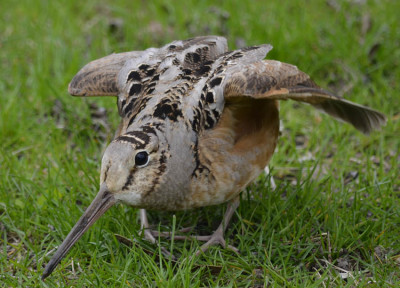
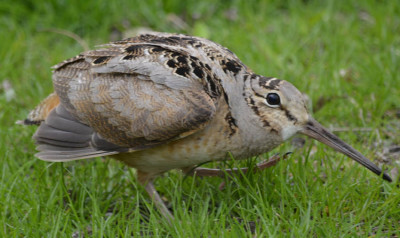
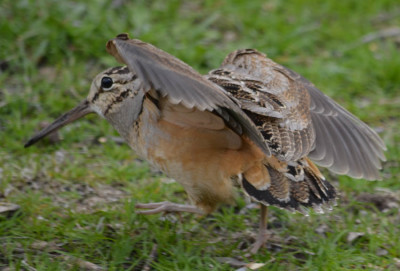
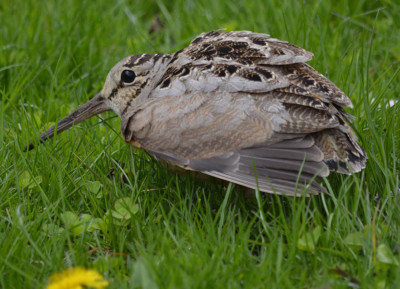
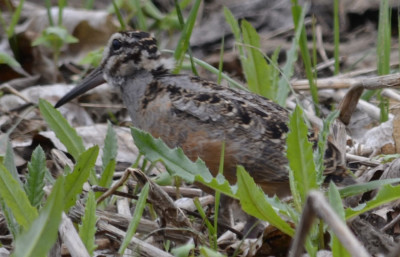
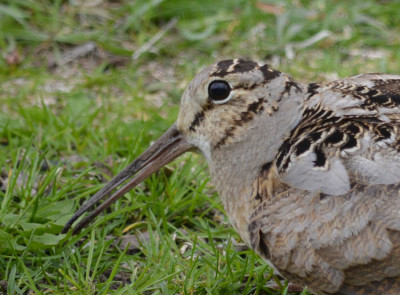

I’m in North Georgia and was out at night near some brush in the back of my land. My dogs were barking in that direction (behind my fence line) when the Woodcock jumped out of the brush and began to walk slowly away from the brush. It was in plain site of my flashlight. A real beauty! I’m so glad to have found what it was.
Thanks for sharing such a great sighting!